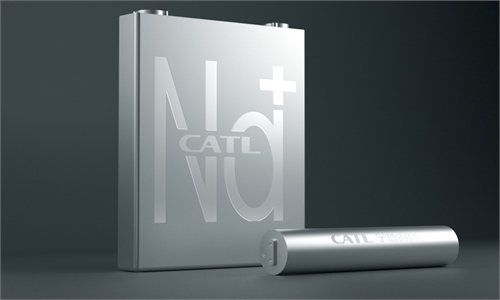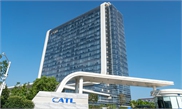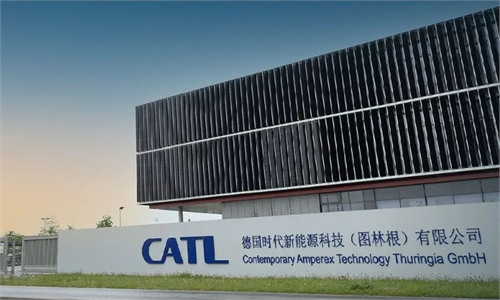A boom city built on electric batteries
Push for green mobility generates increasing opportunities for locals

Two workers from a power supply company check the operation of the energy storage equipment produced by CATL. Photo: VCG
Once known as the "golden fault zone" along the southeastern coast of China, Ningde, East China's Fujian Province, has grown from an economic laggard to become a modern and rich city leading the world in lithium-ion battery manufacturing by riding on the boom of China's electric vehicle (EV) industry amid the country's push for greener mobility.
In the eyes of a 50-something local resident in Ningde, the city is a "black horse" that is racing in full swing and will see more potential being released in the longer term.
"For the general public, Ningde was a lesser-known poor city about decade ago, and I needed to spend a long time to explain where I came from when traveling outside the province. At that time, the city's economic output was second to the last in Fujian," the local resident surnamed Li recalled.
But now Ningde is a household name, Li said, thanks to the rapid rise of electric battery titan Contemporary Amperex Technology (CATL), which was set up in 2011.
Another local resident surnamed Chen, a teacher in the city's largest vocational college, told the Global Times that automobile maintenance has become the "hottest" major among students in Fujian, especially those tailored-made classes for those who sign employment contracts with CATL and the giant automaker SAIC Motor.
"Last year, more than 400 students learning EV graduated, and the employment rate hits 100 percent because automakers here are in dire need of skilled workers," Chen explained, adding that she has already received consulting calls from many students' parents in January, who look to enroll their children in the school's auto-related subject this fall.
Globally leading
A place making strides in social and economic development is usually inseparable from leading companies starting from scratch. For Ningde, the role is undoubtedly played by CATL.
Usually, a lithium-ion battery cell will roll off the assembly line every 1.7 seconds in the Lighthouse factory of CATL, which will be assembled into a battery module every 20 seconds. For every three EVs in the world, one could be equipped with CATL-made batteries.
CATL installed 165.7 gigawatt hours (GWh) of battery cells from January to November in 2022, up 101.8 percent from the same period a year earlier, according to SNE Research. The company's global market share rose from 32.8 percent at the end of 2021 to 37.1 percent last year. It has remained the world's largest vehicle battery maker for six consecutive years.
Propped up by CATL, Ningde introduced other leading players such as state-owned automaker SAIC Motor, which started production of its new vehicle assembly plant in 2019.
Led by these behemoths, Ningde has more than 80 projects over the battery-making industrial chain, and it has forged a comprehensive technology deployment ranging from raw materials, modules and battery management systems to battery recycling, a representative of Ningde's publicity department told the Global Times.
The localization rate of main materials in the battery industry has reached more than 60 percent, enabling Ningde to become the world's largest production base of polymer lithium-ion batteries, the representative said.
In 2022, Ningde's lithium-ion new-energy sector achieved an output value of 275.8 billion yuan ($40.7 billion), a jump of 74.6 percent from 2021, driving an increase of 20.3 percentage points in the industrial added value and becoming the city's first industrial cluster that exceeded 200 billion yuan in revenues.
The city aims to bring its lithium-ion new energy sector to the level of 500 billion yuan by 2025 by accelerating the building-up of a comprehensive supporting facility that will meet domestic demand and also serve global markets.
Thanks to its industrial advantages, Ningde's economic output reached 355.4 billion yuan last year, up 10.7 percent year-on-year, much higher than the national average of 3 percent. The city topped others in Fujian in terms of seven major economic indicators out of 12, according to a local government report in January.
Green endeavor
Behind the success of CATL and the thriving electric battery industry in Ningde is the nation's resolve in pushing forward green growth and achieving the "dual carbon" goals. China aims to reach CO2 emissions peak before 2030 and achieve carbon neutrality before 2060.
New-energy vehicles, including pure battery vehicles and plug-in hybrid electric vehicles and fuel-cell vehicles, have become a strategically important emerging industry in China that's believed to play a driving role in fighting climate change.
China has been the world's largest NEV market for seven years in a row. Sales of NEVs continued to soar last year, driven by the rising market demand and sound policy environment. Sales reached 6.89 million units, skyrocketing 93.4 percent on a yearly basis, according to the China Association of Automobile Manufacturers (CAAM).
NEV production soared 96.9 percent from a year earlier to about 7.06 million units in 2022.
Thanks to the NEV boom, the share of NEVs in China's auto market reached 25.6 percent in 2022, up 12.1 percentage points from 2021.
For 2023, a robust NEV market could be anticipated with the country's optimized COVID-19 management, which could help spur consumer spending and boost supply chains. The CAAM forecast that China's NEV sales would grow 35 percent year-on-year to 9 million units in 2023.





